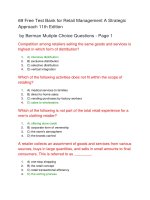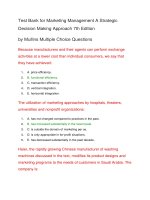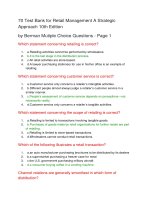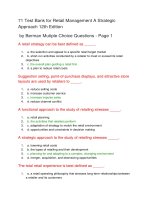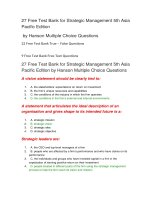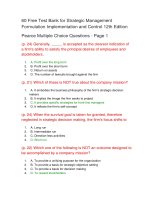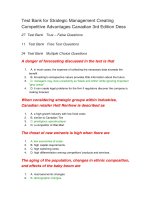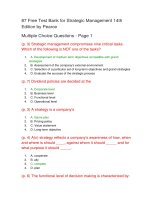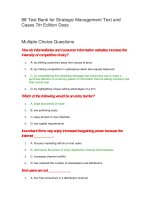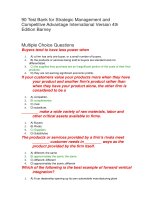113 test bank for strategic management a competitive advantage approach concepts and cases 14th edition david
Bạn đang xem bản rút gọn của tài liệu. Xem và tải ngay bản đầy đủ của tài liệu tại đây (139.81 KB, 25 trang )
Test Bank for Strategic Management A Competitive
Advantage Approach Concepts and Cases 14th
Edition David
Multiple Questions
What question is asked in conjunction with the philosophy
component of a mission statement?
1.
2.
3.
4.
5.
A) What are the firm's major products or services?
B) Is the firm committed to growth and financial soundness?
C) What are the basic beliefs, values, aspirations, and ethical priorities of the firm?
D) Is the firm responsive to social, community, and environmental concerns?
E) Are employees a valuable asset of the firm?
Which of the following illustrates the self-concept
component of a mission statement?
1.
2.
3.
4.
5.
A) To earn our customer's loyalty, we listen to them, anticipate their needs, and act
to create value in their eyes.
B) We are committed to leapfrogging ongoing competition within 1,000 days by
unleashing the constructive and creative abilities and energies of each of our
employees.
C) Our emphasis is on North American markets, although global opportunities will
be explored.
D) To compensate its employees with remuneration and fringe benefits competitive
with other employment opportunities in its geographical area and commensurate
with their contributions toward efficient corporate operations.
E) In this respect, the company will conduct its operations prudently and will
provide the profits and growth which will assure our ultimate success.
The ideal length of a vision statement is
1.
2.
3.
4.
5.
A) one page.
B) several paragraphs.
C) one sentence.
D) several sentences.
E) as long as is necessary to convey the message.
The general public is especially interested in ________,
whereas stockholders are more interested in
________.
1.
2.
3.
4.
5.
A) environmental concerns; social responsibility
B) social responsibility; the treatment of employees
C) the treatment of employees; environmental concerns
D) profitability; social responsibility
E) social responsibility; profitabilityA$52
When developing a mission statement, what is needed
before people can focus on specific strategy
formulation activities?
1.
2.
3.
4.
5.
A) Negotiation
B) Compromise
C) Eventual agreement
D) A and B only
E) All of the aboveA$52
All of the following utility statements are relevant in
developing a mission statement EXCEPT
1.
2.
3.
4.
5.
A) Do not offer me shoes. Offer me comfort for my feet and the pleasure of
walking.
B) Do not offer me furniture. Offer me comfort and the quietness of a cozy place.
C) Do not offer me ideas, emotions, ambience, feelings, and benefits. Offer me
things.
D) Do not offer me books. Offer me hours of pleasure and the benefit of
knowledge.
E) Do not offer me clothes. Offer me attractive looks.
Effective and carefully planned mission statements
1.
2.
3.
4.
5.
A) require major changes every few months.
B) require major changes every few quarters.
C) require major revision every few years.
D) become ineffective in the first year.
E) stand the test of time.A$52
Who is referred to as the father of modern management?
1.
2.
3.
4.
5.
A) Deming
B) Peters
C) Drucker
D) McGinnis
E) Smith
Which component of a mission statement addresses the
firm's distinctive competence or major competitive
advantage?
1.
2.
3.
4.
5.
A) Technology
B) Philosophy
C) Concern for public image
D) Customers
E) Self-conceptA$52
Which component of a mission statement addresses the
basic beliefs, values, aspirations, and ethical priorities
of the firm?
1.
2.
3.
4.
5.
A) Technology
B) Philosophy
C) Concern for public image
D) Customers
E) Self-concept
Which of these basic questions should a vision statement
answer?
1.
2.
3.
4.
5.
A) What is our business?
B) Who are our employees?
C) What are our challenges?
D) What do we want to become?
E) Who are our competitors?
Effective mission statements can vary in
1.
2.
3.
4.
5.
A) length.
B) content.
C) format.
D) specificity.
E) all of the aboveA$52
What can be used to promote unbiased views and to manage
the development of the mission statement more
effectively?
1.
2.
3.
4.
5.
A) An internal group
B) A committee of managers
C) Command-and-control
D) Surveys
E) An outside facilitatorA$52
The purpose of a mission statement is to declare all of these
EXCEPT
1.
2.
3.
4.
5.
A) a reason for being
B) an annual financial plan
C) a statement of purpose
D) a statement of beliefs
E) whom it wants to serve
According to recent studies, what percent of companies
have used a mission statement sometime in the past
five years?
1.
2.
3.
4.
5.
A) 15%
B) 30%
C) 60%
D) 75%
E) 90%A$52
According to McGinnis, a mission statement should be all of
the following EXCEPT
1.
2.
3.
4.
5.
A) it should be specific enough to control creative growth
B) it should be stated in clear terms
C) it should distinguish an organization from all others
D) it should define what an organization is
E) it should serve as a framework for evaluating both current and prospective
activities
A business' mission is the foundation for all of the following
EXCEPT
1.
2.
3.
4.
5.
A) priorities
B) strategies
C) plans
D) employee wage rates
E) work assignments
Which of these examples of a mission statement's focus
area does NOT identify the utility of the firm's products
to its customers?
1.
2.
3.
4.
5.
A) AT&T focuses on communication rather than telephones.
B) ExxonMobil focuses on oil and gas rather than energy.
C) Union Pacific focuses on transportation rather than railroads.
D) Universal Studios focuses on entertainment rather than movies.
E) Starbucks focuses on the café experience rather than coffee.
Which type of statement should be created first and
foremost?
1.
2.
3.
4.
5.
A) Strategic
B) Vision
C) Objectives
D) Mission
E) Competitive advantage
An effective mission statement does all of the following
EXCEPT
1.
2.
3.
4.
5.
A) it reflects judgments about future growth directions that are based upon
forward-looking external and internal analyses
B) it provides useful criteria for selecting among alternative strategies
C) it provides a basis for generating and screening strategic options
D) it is static in orientation
E) it should be enduring
In developing a mission statement, arousing emotion
1.
2.
3.
4.
5.
A) is not a benefit.
B) is futile.
C) is important.
D) should be avoided if possible.
E) is counterproductive.
Which question(s) are answered in an effective mission
statement?
1.
2.
3.
4.
5.
A) Is the firm committed to growth and financial soundness?
B) Are employees a valuable asset of the firm?
C) Geographically, where does the firm compete?
D) Who are the firm's customers?
E) All of the aboveA$52
A study by Rarick and Vitton found that firms with a
formalized mission statement have ________ the
average return on shareholders' equity than those
firms without a formalized mission statement.
1.
2.
3.
4.
5.
A) one-quarter
B) half
C) twice
D) three times
E) five times
An overly general mission statement that ________ could be
dysfunctional.
1.
2.
3.
4.
5.
A) does not exclude any strategy alternatives
B) encourages management creativity
C) excludes all diversification
D) endorses the consideration of feasible potential strategies
E) allows for the generation and consideration of a range of alternative objectives
In the process of developing a mission statement, it is
important to involve
1.
2.
3.
4.
5.
A) as few managers as possible.
B) as many managers as possible.
C) upper-level management only.
D) lower-level management only.
E) the board of directors only.
The recommended length of an effective mission statement
is ________ words.
1.
2.
3.
4.
5.
A) approximately 25
B) no more than 100
C) less than 250
D) at least 300
E) more than 500
Which of the following is NOT one of the nine recommended
components of a mission statement?
1.
2.
3.
4.
5.
A) Strategies
B) Self-concept
C) Concern for employees
D) Markets
E) Customers
The vision statement answers which question?
1.
2.
3.
4.
5.
A) What is our business?
B) How can we improve ourselves?
C) What do we want to become?
D) Who are our stakeholders?
E) How can we increase profitability?
After a draft mission statement has been developed, it is
important to
1.
2.
3.
4.
5.
A) ask managers to read several articles about mission statements as background
information.
B) vote on the mission statement.
C) ask managers to prepare a mission statement for the organization.
D) ask managers to seek support for the mission statement from their
subordinates.
E) request modifications, additions, and deletions to the mission statement.A$52
King and Cleland recommend that organizations carefully
develop a written mission statement for all of the
following reasons EXCEPT
1.
2.
3.
4.
5.
A) to provide a basis for allocating organizational resources
B) to establish a general tone or organizational climate
C) to ensure unanimity of purpose within the organization
D) to ensure a command-and-control structure
E) to facilitate the translation of objectives into a work structure involving the
assignment of tasks to responsible elements within the organization
Business Week reports that firms using mission statements
have a ________ percent higher return on certain
financial measures than those without such
statements.
1.
2.
3.
4.
5.
A) 10
B) 15
C) 30
D) 45
E) 50
What is the first step in the comprehensive strategicmanagement model?
1.
2.
3.
4.
5.
A) Developing vision and mission statements
B) Performing external audits
C) Performing internal audits
D) Measuring and evaluating performance
E) Establishing long-term objectives
According to the comprehensive strategic-management
model, which step needs to be completed immediately
following the establishment of long-term objectives?
1.
2.
3.
4.
5.
A) Developing vision and mission statements
B) Performing external audits
C) Performing internal audits
D) Generating, evaluating, and selecting strategies
E) Measuring and evaluating performance
As indicated in the strategic-management model, a clear
________ is needed before long-term objectives can be
established.
1.
2.
3.
A) short-term objective
B) implementation plan
C) audit policy
4.
5.
D) mission statement
E) evaluation strategy
The following excerpt from a mission statement illustrates
which of the nine essential components of a mission
statement? "We believe our first responsibility is to the
doctors, nurses, patients, mothers, and all others who
use our products and services."
1.
2.
3.
4.
5.
A) Markets
B) Customers
C) Concern for Employees
D) Concern for Public Image
E) Technology
All stakeholders
1.
2.
3.
4.
5.
A) have claims and concerns about an organization, but these claims and
concerns vary.
B) have the same claims and concerns about an organization.
C) have ownership rights in an organization.
D) have the same voting rights in an organization.
E) have environmental concerns as their top priority.
The mission statement answers which question?
1.
2.
3.
4.
5.
A) What is our business?
B) How can we improve ourselves?
C) What do we want to become?
D) Who are our stakeholders?
E) How can we increase profitability?
The potential for creative growth in an organization can be
limited by
1.
2.
3.
4.
5.
A) an overemphasis on stakeholders.
B) not enough emphasis on stakeholders.
C) a mission statement that is too general.
D) a mission statement that is too specific.
E) a mission statement that is too dynamic.
A good mission statement has
1.
2.
3.
4.
5.
A) an employee orientation.
B) a customer orientation.
C) a shareholder orientation.
D) an environmental orientation.
E) a profit orientation.
An effective mission statement should do all of the following
EXCEPT
1.
2.
3.
4.
5.
A) include monetary amounts, numbers, percentages and ratios
B) be inspiring
C) reveal that the firm is environmentally responsible
D) identify the utility of a firm's products
E) be reconciliatory
All of the following are mentioned as places where vision
and mission statements can often be found EXCEPT
1.
2.
3.
4.
5.
A) SEC reports
B) annual reports
C) customer service agreements
D) supplier agreements
E) business plans
The process of developing a vision and mission statement
often includes which of these as the first activity?
1.
2.
3.
4.
A) Requesting that managers modify the current document
B) Asking managers to read selected articles about mission statements
C) Asking managers to prepare a mission statement for the organization
D) Having a brainstorming session on whether the organization should have a
mission statement
5. E) Merging several mission statements into one document
What is the best time to develop a mission statement?
1.
2.
3.
4.
5.
A) Before a business is opened
B) When the firm is successful
C) When the firm is in financial trouble
D) When the firm is in legal trouble
E) When the firm encounters competition
Which group would be classified as stakeholders?
1.
2.
3.
4.
5.
A) Governments
B) Creditors
C) Suppliers
D) Employees
E) All of the aboveA$52
According to Campbell and Yeung, what is/are most likely
associated with behavior and the present?
1.
2.
3.
A) Mission
B) Values
C) Long-term objectives
4.
5.
D) Vision
E) Possibilities
All stakeholders' claims on an organization ________
pursued with equal emphasis.
1.
2.
3.
4.
5.
A) cannot be
B) should always be
C) are required to be
D) must ideally be
E) can usually be
Good mission statements identify the ________ of a firm's
products to its customers.
1.
2.
3.
4.
5.
A) utility
B) price
C) profit margin
D) demand
E) popularity
In order to appeal to its diverse stakeholders, an effective
mission statement should be
1.
2.
3.
4.
5.
A) inflammatory.
B) provocative.
C) contentious.
D) reconciliatory.
E) dysfunctional.
True - False Questions - Page 1
According to Campbell and Yeung, the process of
developing a mission statement should create an
"emotional bond" and "sense of mission" between the
organization and its employees.
1.
2.
True
False
In multidivisional organizations, each division should
develop a mission statement consistent with and
supportive of the corporate mission.
1.
2.
True
False
In order to motivate a workforce effectively, both profit and
vision are needed.
1.
True
2.
False
The mission statement should be short — preferably one
sentence.
1.
2.
True
False
A mission statement is a declaration of an organization's
financial status.
1.
2.
True
False
A mission statement is usually just a simple statement of
specific details.
1.
2.
True
False
The foundation for development of a comprehensive mission
statement is provided by a clear vision.
1.
2.
True
False
When developing a vision statement, input should be
received from as many managers as possible.
1.
2.
True
False
According to King and Cleland, carefully developed and
written mission statements ensure unanimity of
purpose within the organization.
1.
2.
True
False
Although it is important for companies to have a clearly
defined mission statement, research has shown that
less than 50% of all companies have used a mission
statement in the previous five years.
1.
2.
True
False
A mission statement can sometimes be called a statement of
philosophy.
1.
2.
True
False
When developing a mission statement, it is usually advisable
to involve as few managers as possible.
1.
2.
True
False
According to Campbell and Yeung, an organization's vision
is associated with behavior and with the present.
1.
2.
True
False
A mission statement is a declaration of an organization's
reason for being.
1.
2.
True
False
Whereas the mission statement answers the question, "What
do we want to become?," the vision statement
answers the question, "What is our business?"
1.
2.
True
False
If an organization chooses to have both a mission and a
vision, the mission statement should be established
first.
1.
2.
True
False
According to Peter Drucker, asking the question "What is our
business?" is synonymous with asking the question
"What is our vision?"
1.
2.
True
False
A mission statement promotes a sense of shared
expectations among all levels and generations of
employees.
1.
2.
True
False
Mission statements are sometimes difficult to derive
because top management may disagree over company
objectives.
1.
2.
True
False
Carefully prepared statements of vision and mission are
widely recognized as the first step in strategic
management.
1.
2.
True
False
When a company has been successful the question "What is
our business?" becomes unnecessary.
1.
2.
True
False
According to Drucker, the most important time for a
company to develop mission and vision statements is
when the company is experiencing financial difficulty.
1.
2.
True
False
Small, nonprofit organizations never develop mission
statements.
1.
2.
True
False
An important question a mission statement should answer
is, "What do we want to become?"
1.
2.
True
False
Vision and mission statements can often be found in the
front of annual reports.
1.
2.
True
False
Mission statements provide managers with a unity of
direction that transcends individual, parochial and
transitory needs by promoting a sense of shared
expectations among all levels and generations of
employees.
1.
2.
True
False
A mission statement, sometimes called a creed statement,
can be defined as an enduring statement of purpose
that distinguishes one organization from other similar
enterprises.
1.
2.
True
False
The first step in the process of developing a mission
statement is to ask all participants to prepare what
they believe the organization's mission should be.
1.
2.
True
False
Research has failed to find a positive relationship between
mission statements and organizational performance.
1.
2.
True
False
57 Free Test Bank for Strategic Management A
Competitive Advantage Approach Concepts and
Cases 14th Edition David True - False Questions Page 2
A mission statement should be broad enough to reconcile
differences among an organization's various
stakeholders.
1.
2.
True
False
According to Peter Drucker, developing a clear business
vision and mission is the first responsibility of
strategists.
1.
True
2.
False
A firm's concern for employees in a mission statement
addresses the question, "Is the firm responsive to
social, community, and environmental concerns?"
1.
2.
True
False
Having a clear mission and vision can provide a basis for a
company's internal and external assessment.
1.
2.
True
False
A good mission statement serves as a framework for
evaluating both current and prospective activities.
1.
2.
True
False
A firm's philosophy in a mission statement addresses the
question, "What is the firm's distinctive competence?"
1.
2.
True
False
Stakeholders both affect and are affected by an
organization's strategic decisions.
1.
2.
True
False
The operating philosophy of organizations should be to
develop a product and then try to find a market for it.
1.
2.
True
False
Mission statements cannot be stated with too high a level of
specificity.
1.
2.
True
False
The utility statement, "Do not offer me attractive looks; offer
me clothes," is relevant in developing a mission
statement.
1.
2.
True
False
Well-conceived and properly executed mission and vision
statements do not need to be subject to revision.
1.
2.
True
False
An effective mission statement generates the impression a
firm is successful, has direction, and is worthy of time,
support and investment.
1.
2.
True
False
AT&T's mission statement focuses on telephones rather than
on communication.
1.
2.
True
False
Good mission statements identify the utility of a firm's
products to its customers.
1.
2.
True
False
According to Vern McGinnis, an effective mission statement
should define what the organization is and what the
organization aspires to be.
1.
2.
True
False
It is unusual for the claims and concerns of a company's
stakeholders to vary or conflict.
1.
2.
True
False
Individuals who own stock in a corporation are considered
stakeholders.
1.
2.
True
False
One of the benefits of having a clear mission and vision is
promoting a sense of shared expectations among all
managers and employees.
1.
2.
True
False
Union Pacific's mission statement focuses on transportation
rather than on railroads because good mission
statements identify the utility of a firm's products to its
customers.
1.
2.
True
False
Attracting customers is a major reason for developing a
mission statement.
1.
2.
True
False
The relative attention an organization will devote to meeting
the claims of various stakeholders is indicated in a
good mission statement.
1.
2.
True
False
According to George Steiner, vagueness has no place in a
good mission statement.
1.
2.
True
False
In most cases, at least 500 words are required to effectively
state a mission statement.
1.
2.
True
False
A mission statement should be broad in scope, since
concrete specification could be the base for rallying
opposition.
1.
2.
True
False
A mission statement that is limited enough to exclude some
ventures is a poor mission statement.
1.
2.
True
False
A sense of self-concept is one of the nine components a
good mission statement should include.
1.
True
2.
False
Stakeholders of an organization include stockholders,
customers and creditors, but not competitors.
1.
2.
True
False
Excess specificity can stifle creativity in the formulation of
an acceptable mission or purpose.
1.
2.
True
False
Free Text Questions
King and Cleland recommend organizations carefully
develop a written mission statement for six reasons.
List and describe five of these reasons.
Answer Given
There are six reasons King and Cleland give to develop a mission statement.
Students may list and describe any five of the following: 1) to ensure unanimity of
purpose within the organization, 2) to provide a basis, or standard, for allocating
organizational resources, 3) to establish a general tone or organizational climate,
4) to serve as a focal point for individuals to identify with the organization's
purpose and direction, and to deter those who cannot from participating further in
the organization's activities, 5) to facilitate the translation of objectives into a work
structure involving the assignment of tasks to responsible elements within the
organization, and 6) to specify organizational purposes and then to translate these
purposes into objectives in such a way that cost, time and performance
parameters can be assessed and controlled.
A good mission statement effectively reflects the
anticipations of customers and reveals the utility that
various products or services offer customers. Give
three examples of this.
Answer Given
Student answers may vary, but could include: 1) AT&T's mission statement
focuses on communication rather than on telephones; 2) Exxon's mission
statement focuses on energy rather than on oil and gas; 3) Union Pacific's mission
statement focuses on transportation rather than on railroads; and/or 4) Universal
Studios' mission statement focuses on entertainment rather than on movies.
Define and give an example of the self-concept component in
a mission statement.
Answer Given
The self-concept component of a mission statement asks the question, "What is
the firm's distinctive competence or major competitive advantage?" An example of
the self-concept component is, "Crown Zellerbach is committed to leapfrogging
ongoing competition within 1,000 days by unleashing the constructive and creative
abilities and energies of each of its employees."
Explain the process of developing a mission statement.
Answer Given
A widely used approach to developing a mission statement is first to select several
articles about mission statements and ask all managers to read these as
background information. Then ask managers themselves to prepare a mission
statement for the organization. A facilitator or committee of top managers should
then merge these statements into a single document and distribute this draft
mission statement to all managers. A request for modifications, additions and
deletions is needed next, along with a meeting to revise the document. To the
extent all managers have input into and support the final mission statement
document, organizations can more easily obtain managers' support for other
strategy formulation, implementation and evaluation activities.
Describe why a mission statement is so important in the
strategic-management process.
Answer Given
A clear mission statement is essential for effectively establishing objectives and
formulating strategies. It reveals what an organization wants to be and whom it
wants to serve. A business mission is the foundation for priorities, strategies, plans
and work assignments. It is the starting point for the design of managerial jobs and
for the design of managerial structures.
List and define the major components of an effective mission
statement.
Answer Given
Students should list and define the following components of an effective mission
statement: 1) customers, 2) products or services, 3) markets, 4) technology, 5)
concern for survival, growth and profitability, 6) philosophy, 7) self-concept, 8)
concern for public image and 9) concern for employees.
List the two major characteristics of an effective mission
statement.
Answer Given
The major characteristics of an effective mission statement are a declaration of
attitude and a customer orientation.
Compare and contrast vision statements with mission
statements.
Answer Given
Many organizations develop both a mission statement and a vision statement.
Whereas the mission statement answers the question, "What is our business," the
vision statement answers the question, "What do we want to become?" When
employees and managers together shape or fashion the vision and mission
statements for a firm, the resultant documents can reflect the personal visions
managers and employees have in their hearts and minds about their own futures.
Shared vision creates a commonality of interests that can lift workers out of the
monotony of daily work and put them into a new world of opportunity and
challenge.
